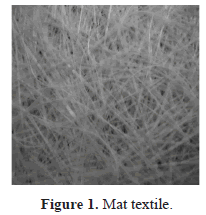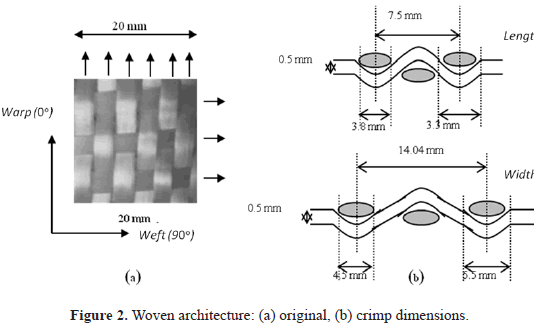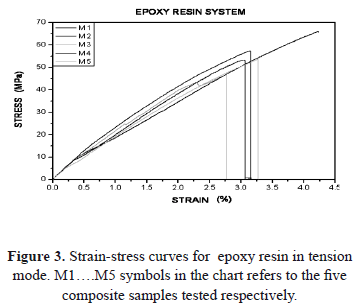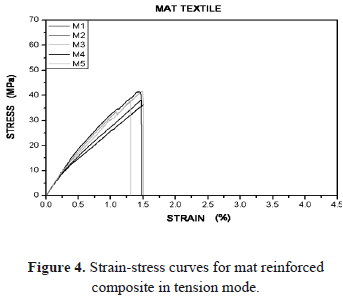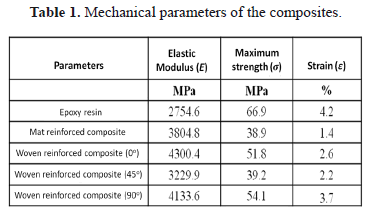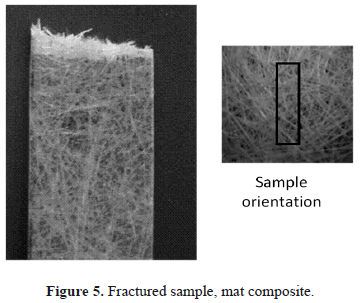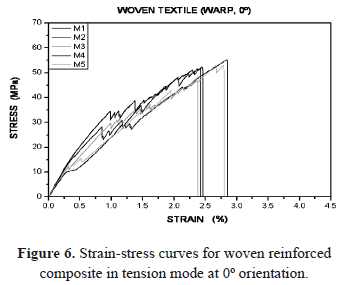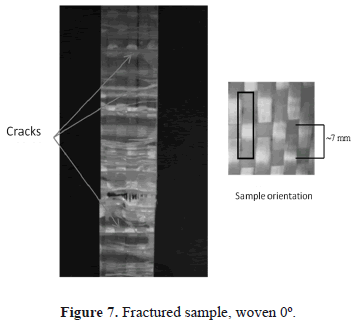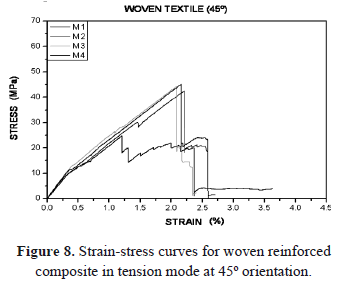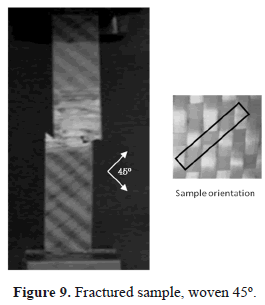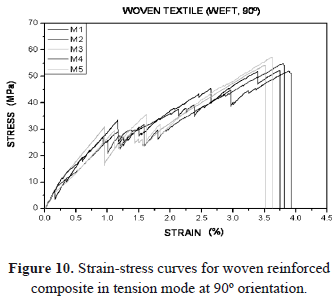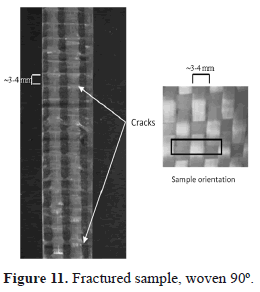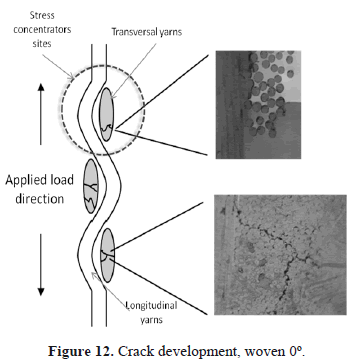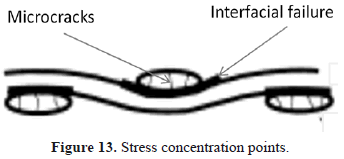Services on Demand
Journal
Article
Indicators
-
 Cited by SciELO
Cited by SciELO -
 Access statistics
Access statistics
Related links
-
 Cited by Google
Cited by Google -
 Similars in
SciELO
Similars in
SciELO -
 Similars in Google
Similars in Google
Share
DYNA
Print version ISSN 0012-7353
Dyna rev.fac.nac.minas vol.79 no.176 Medellín Nov./Dec. 2012
STUDY OF MECHANICAL BEHAVIOR OF TEXTILE REINFORCED COMPOSITE MATERIALS
ESTUDIO DEL COMPORTAMIENTO MECANICO DE MATERIALES COMPUESTOS REFORZADOS CON TEXTILES
CARLOS ROLANDO RIOS-SOBERANIS
PhD, Centro de Investigación Científica de Yucatán, rolando@cicy.mx.
RICARDO HERBE CRUZ-ESTRADA
PhD, Centro de Investigación Científica de Yucatán, rcruze@cicy.mx.
JOSE RODRIGUEZ-LAVIADA
M.Sc, Centro de Investigación Científica de Yucatán, rlaviada@cicy.mx.
EMILIO PEREZ-PACHECO
PhD, Instituto Tecnológico Superior de Calkiní en el Estado de Campeche, eperez@itescam.edu.mx
Received for review March 15th, 2012, accepted August 2th, 2012, final version August, 14th, 2012
ABSTRACT: The relationship between fiber geometry and the damage sequence under tensile loading has been investigated for a composite material reinforced with different textiles architectures such as mat (random fibers) and woven (biaxial). These composites are based on epoxy resin matrix cured with high temperature hardener. The system chosen for this work consists of a bifunctional epoxy, diglycidyl ether of bisphenol A (DGEBA), cured with a tetrafunctional amine, diaminodiphenyl sulfone (DDS). This system ensures the obtaining of a rigid transparent material with excellent mechanical properties in order to observe, analyze and identify the process and progress of the generated damage and the failure mechanism which leads to the materials fracture. Results demonstrated that the reinforcement textile architecture/geometry affects the generation of stress concentration sites augmenting the possibility of failure initiation and cracks propagation.
KEYWORDS: Composite materials, textiles, mechanical characterization.
RESUMEN: La relación entre la geometría del entramado de las fibras y los mecanismos de fractura bajo cargas de tensión ha sido evaluada para materiales compuestos reforzados con textiles de diferente arquitectura tales como colchoneta (fibras al azar) y petatillo (biaxial). Estos materiales están manufacturados empleando como matriz polimérica resina epóxica curada a altas temperaturas. El sistema elegido para este trabajo consiste en resina epóxica bifuncional diglicidil éter de bisfenol A (DGEBA) curada con una amina tetrafuncional diaminodifenil sulfona (DDS). Este sistema asegura la obtención de un material rígido transparente con excelentes propiedades mecánicas que permite observar, analizar e identificar el proceso y el progreso del daño generado así como los mecanismos de fractura que conllevan a la ruptura del material. Los resultados demostraron que la arquitectura/geometría de los textiles de refuerzo influye en la generación de sitios de concentración de esfuerzos donde se incrementa la posibilidad de iniciación de fallas y la propagación de grietas.
PALABRAS CLAVE: Materiales compuestos, textiles, caracterización mecánica.
1. INTRODUCTION
Textiles are found to be among the most efficient reinforcements for composite materials, using textiles, the employment of fibers such as carbon, glass, etc has been augmented in several industrial applications [1]. These composite materials allow the manufacture of complex shapes in a single operation or process. The obtaining of such parts is not easy since all possible shapes depend on the orientation and mechanical behavior of the textile during the forming process, previous to the polymeric resin application. Mechanical behavior of textile fibers is influenced by the knitting pattern which affects the composite mechanical properties at a macroscopic level [1-3]. In order to design a structural material, an experimental investigation is required to understand the mechanical parameters of the chosen materials to be used in the manufacture of the composite (matrix and reinforcement). Due to the textile technological development and the ability to be assembled in different arrangements and configurations, textiles have incremented their field of application [4], far beyond its daily use in the clothing industry. Nowadays they are an important component in the fabrication of high tech engineering materials as reinforcements since textiles exhibit unique properties. However, studies to understand textiles mechanical behavior are yet very limited [1-4]. Nevertheless, some works have reported the mechanical advantages offered by textiles when they are employed as reinforcements in composites [5-7]. Such investigations have demonstrated the intimate relationship between the architecture/geometry of the fabric fibers, with the development and propagation of generated damage under application of external stresses. Different mechanisms of fracture have been also suggested to dominate the coalescence of cracks. The present study is focused on the determination of mechanical parameters in textile reinforced composite materials with different fiber architecture/geometry. The applied stress direction is correlated with textile geometry.
2. MATERIALS
Composite materials studied in this research were manufactured using epoxy resin as a matrix reinforced with textiles made up of glass fiber type E. The epoxy system chosen consisted of resin D.E.R 331 from Dow Company which is a liquid resin of low viscosity and high content of epoxy groups. The hardener used was 4,4'-diaminodiphenylsulfone (DDS) from Aldrich which is an aromatic amine with functionality 4, molecular weight 248.3 gr/mol and melting point of 175-177ºC. DDS is commonly used for high temperature crosslinking processes in order to obtain high brittleness in the composite. Two textiles of defined architecture were used as reinforcement and their characteristics are as follows:
Mat textile: Glass fiber geometry is completely random with fibers dimensions of about 15-30 cm long in average. Figure 1 presents an actual size image of the mat textile.
Woven textile: Constituted of glass fiber type E of 0.4 N/tex, which is identified by its two main directions (length and width) as it is woven it is typified as a biaxial fabric. It is very important to notice that direction in the textile length is referred as 0o (warp), while the width is referred a 90o (weft). Figure 2a shows an image of the original textile where it is possible to identify the two main directions. It is also important to mention that, in 20 mm2 of the fabric, 6 yarns running on warp direction (0o) and only 3 yarns in weft direction (90o) are found. However, yarns running in weft direction (90o) are slightly thicker (a higher number of filaments) than those oriented at warp (0o). Both textiles were acquired from Norteen Fiberglass Inc.
3. EXPERIMENTAL METHOD
A composite material with low fiber volume fraction was manufactured by a wet lay-up process. One layer of textile was used as reinforcement and an epoxy resin system as a matrix. No surface modification was done by a coupling agent. The resin system was placed in a mold and then, the textile was placed in the mold assuring a complete diffusion of the resin between the fabric filaments. The mold was placed in an oven for curing at 140ºC during 8 hrs. After this time, the lamina was cooled down at room temperature and finally it was withdrawn from the oven. Samples were obtained from the laminas for mechanical testing. Volume fraction (Vf) was obtained by using the matrix burning method which consists in placing samples from the lamina in a furnace at 600ºC during 2 hrs. A Shimadzu universal machine was used to carry out the mechanical testing and the crack development analysis by using a loading cell of 5 kN. The cross-head speed for all tests was kept constant at 0.5 mm/min.
4. RESULTS
Mat textile:
Mat textile was the first fabric used as reinforcement which posses an undefined architecture with long fibers randomly dispersed.
For this reason a mechanical test in tension mode was carried out on samples manufactured in only one direction by taking into account the isotropic characteristics of this fabric. Typical stress vs. strain curves can be observed in Figure 3 and Figure 4 for the epoxy system and the composite material respectively. A mat textile reinforced composite provides a slight increment in the resistance (elastic modulus) with respect to the epoxy resin properties increasing from 2,754 MPa to 3,804 MPa. However the elongation decreases approximately 50% due to the effect caused by the amount of fibers which augments the stiffness in the thermosetting matrix. There is also a reduction in the ultimate strength between the epoxy matrix and the composite from 66.9 MPa to 38.9 MPa respectively. This is clearly observed in Table 1, in which, for comparative reasons, mechanical parameters obtained from the epoxy system without reinforcement, the mat reinforced composite and the woven reinforced composite in its three different directions are displayed. Results from these analyses discussed with more detail later on.
In this case, mat reinforced composite samples did not exhibit a progressive crack development since the material samples suffered catastrophic fracture with the first major signal of failure. In the stress-strain curve there is no discontinuity that could be related to previous damage indicating the initiation of failure. Figure 5 illustrates the fracture zone of the composite samples tested in tension. Random orientation of the fibres can be observed due to the transparency of the resin. Composite material fiber volume fraction (Vf) was calculated to be 13% on average.
From this failure mode three aspects can be observed:
- No dominion of the textile geometry (long fibres randomly oriented) over the mechanisms of fracture was identified since all fibres suffered initial interface delamination.
- Subsequent transversal crack development and coalescence of the initial crack induce the final fracture.
- Samples did not display any cracking pattern along the sample previous to total failure since they fractured with the first main crack.
In this research, mat reinforced epoxy composite materials were only mechanically evaluated in the direction in which the load is applied in tension (0º) in order to analyze the cracking density and development. Results were similar to those obtained by Kim et al. [8] who proved that fracture mechanisms depends on the reinforced textile orientation in the tested samples. When samples are tested in different directions in relation to the mat textile geometry, i.e. at 0º (length of the textile) or at 90º (width of the textile) there is a small anisotropy due to the amount of fibers, commonly behaving differently in any direction. Fracture mechanisms observed are governed by matrix/fiber interfacial failure. Mat textile architecture lacks enough unidirectional fibers along the applied stress axis to support the transference of load. Therefore crack appears in weak sites allowing the failure to develop transversally to the applied load direction. Growth of additional cracks along the sample is avoided since the initial crack has enough energy to take the sample to a catastrophic fracture. This phenomenon was observed by Y. Mahadik et al. [9] who reported more dispersed mechanical parameter values obtained from mat reinforced epoxy composites than unidirectional or biaxial composites.
Woven textile:
The second textile used as reinforcement was plain woven fabric. For this woven textile reinforced composite, the mechanical parameters were measured varying the sample orientation in relation to the applied stress axis at 0º, 45º and 90º taking in account, as mentioned before, its two main directions (warp and weft).
Woven reinforced composite at 0º (Warp):
Typical stress vs. strain curves for these samples oriented in the warp direction exhibited several discontinuations (Figure 6) indicating the successive appearance of mayor cracks (visible and audible) along the material. These cracks ran transversally from side to side of the sample, perpendicular to the loading direction.
Table 1 presents the numerical values of the mechanical parameters where it is possible to observe the effect induced by the reinforcement with a defined geometry, such as woven. In this case the elastic modulus augmented 13%, the maximum stress increased 33% and the elongation reached 85% in relation to the corresponding values obtained for mat reinforced composite. This difference is due to the higher amount of unidirectional fibres oriented to the loading direction (parallel to the applied stress).
It is possible to observe in the fractured sample (Figure 7) the damage pattern and the spaces between the fissures running transversally as delaminations in the fiber/matrix interface zone (blue arrows). These cracks, perpendicular to the applied load, presented interspaces of about 7 mm, which is possibly related to the separation distance between the transversal yarns of the woven fabric.
Woven reinforced composite at 45º:
The stress-strain curves for this material are displayed in figure 8. These samples oriented at 45º exhibited a minimum of discontinuities before maximum stress, less than the damage sequence observed when oriented at 0º and 90º. The arrangement of threads at 45º lacks parallel filaments (unidirectional) to the loading direction. Therefore cracks are easily formed and total fracture appears with the first sign of damage. Transference of load from matrix to fibers is not good enough to bear the tension load. Consequently, cracks coalesce between the points where tows cross each other perpendicularly at 45º. In this particular case, samples did not present a successive damage development since some of them fractured when the first visible crack appeared; therefore damage was only noticed around the fractured area. No damage pattern was observed. Table 1 presents the numerical values of the mechanical parameters. For these samples, the mechanical properties tend to decrease in comparison with samples oriented at 0º.
As shown in figure 9, failure develops and propagates in the rich resin zones around the yarns intersection (crimps oriented at 45º) diminishing the strength of the material.
Woven reinforced composite at 90º (Weft):
Similarly to the stress vs. strain curves found for warp (0º) direction samples, at 90º they presented several discontinuities (Figure 10) related to damage progression of transversal cracks along the samples. They also exhibited higher crack density (number of cracks/area). The values for the mechanical parameters are displayed in Table 1. These results are very similar to those found for warp direction (0º) samples. Such similarity is due to the almost identical amount of fibers in both directions (0º and 90º) despite the dissimilar amount of yarns. As it was mentioned before, less yarns are oriented at 90º than those at 0º however they are wider containing a higher amount of fibers per thread.
Fractured samples exhibited several transversal cracks along the tested material similarly to the damage pattern identified at 0º orientation samples but in higher numbers (Figure 11). This cracking pattern is intimately related to the woven textile architecture which generates a successive cracking sequence with a distance space between cracks of about 3 to 4 mm. Fiber volume fraction (Vf) of the composite material reinforced with woven textile was calculated to be 16% on average.
Fractography:
Several damaged samples oriented at 0º and 90º prior to total fracture, were chosen to be polished in order to be inspected under the scanning electronic microscope (SEM) to identify the possible initiation sites. This fractographic analysis demonstrated that transversal cracks are apparently developed perpendicularly to the loading direction through fibre/matrix delaminations from side to side of the samples.
Most transversal cracks were observed to appear at the samples edges through small delaminations in the interbundle interface area between orthogonal threads. Microscopic analysis identified the extreme points and the middle zone of the transversal bundles (crimp regions) as the probable origin of the crack initiation as illustrated in figure 12. These cross-over sites are considered as stress concentrators where it is possible to find crack initiation points.
Damage mechanisms exhibited by woven textile reinforced composites oriented at 0º and 90º results from the transversal cracking generated by delamination of perpendicular yarns in mechanical response to the applied load stress. On the other hand, at 45º sample cracks form in the crimp sites (cross-over) where yarns are laced in a 90º angle and they propagate catastrophically, developing a damaged area just around the main crack and not along the tested material.
Paepegem and Degrieck [10] established a difference in the failure modes at 0º and 45º in composite materials reinforced with woven textiles when samples were submitted to flexure and tension stresses finding, by this means, an influence of the unidirectional yarns orientation over the damage generation and propagation. It was found that crack density was incremented proportionally to the applied load, with main cracks running along the fibers of the transversal threads. Additionally major amount of flaws are found around the fractured zone. Detailed morphology of the cracks depends on the geometry of the yarns (lineal or twisted). Twisted yarns lead to the generation of fragmented cracks in the matrix phase while lineal yarns, such as the woven fabric employed in this research, create transversally developed matrix cracking that resembles the failure mode observed on 0º/90º laminates (cross-ply) [11-13].
In accordance to the results obtained in this work, damage is propagated perpendicular to the applied load axis. Ravi et al [14] identified similar fracture mechanisms; additionally, they demonstrated that, at low volume fractions, damage appears as flaws in the interphase region and matrix cracks, whereas delamination dominates failure mechanisms in composites with higher fiber contents. Initiation sites were identified in the crimp region where fiber threads cross over each other (cross-over points) generating high stress concentration that eventually leads to a complete fracture of the material. Such statements have been also observed by Wen et al. [15] in their research, in which, units of damage accumulation areas were identified. They consider the possibility that several damaged units (unitary cells) are produced randomly anywhere inside the composite in an intermediate stage where a gradual decrease of modulus represents the accumulated sum of the damaged units that exhibit different degrees of deterioration.
On the other hand, woven textile architecture, has a biaxial reinforcement and the type of interlace, seems to have an important influence in the development and propagation of flaws. Therefore, this factor must be widely considered during the process and manufacture of a textile reinforced composite material as was identified by Kuo et al [16]. These researchers examined how different processes of interweaving in woven textiles affect fiber orientation as well as the effect of the resultant geometry in the induced damage behavior. Additionally, they found significant differences in the mechanisms of crack generation dictated by the fabric architecture.
Fiber volume fraction is an important consideration to be taken into account when manufacturing textile reinforced composite materials. This is a key factor influencing the mechanical properties and behavior that can lead to ductile (plastic) or rigid (brittle) characteristics. In order to obtain the fiber volume fraction (Vf) of the composites evaluated in this research, a matrix burning technique was employed (ASTM D 2584 - 02). In this method a piece of material is heated to high temperatures allowing the polymeric matrix to be completely eliminated leaving only the glass fibers. The volume fraction obtained for Mat textile and Woven textile were 13% and 16% respectively. Textile reinforced composite materials tested in this work exhibited low values of fiber volume fraction as a result of the addition of only one fabric layer to the polymeric matrix. This allows clear visualization through the material in order to observe the generated damage initiation and development until total fracture occurs. Generally, low volume fraction composites are obtained when they are reinforced with only one layer of the textile despite its fiber density or type of interweaving [17, 18]. This condition ensures an excellent observation and monitoring in “real time” of the crack evolution. Composites with higher fiber content (40%) are considered as structural materials and it is very difficult to evaluate, in detail, the mechanisms of fracture in them.
Failure mechanisms of the woven textile reinforced composites can be resumed in the following statements:
- The woven textile exhibited biaxial reinforcement characteristics when submitted at tension stresses in its two principal directions warp and weft (0º y 90º). Unidirectional yarns, oriented parallel with respect to the applied load axis, support the transference of load between the matrix and reinforcement more efficiently.
- In both of the main directions (0º y 90º) a saturation of transversal cracks along the sample was observed. These cracks were developed in the matrix/fiber interface region and they coalesce as a significant crack from one side to another of the sample. Distance between cracks was determined to be consistent with the woven textile dimensions. On the other hand, samples oriented at 45º did not exhibit an adequate resistance along the applied load axis; consequently they tend to fracture at lower stresses since there are no unidirectional fibers that could stand the distribution of stresses in the material. In these composite samples cracks are initiated in the cross over sites where warp and weft yarns are perpendicular and promote damage propagation.
- Microscopic evaluation indicated that cracks are initiated in the crimp zones within the bundle, into the fibers that form the thread (oval shape). Cross-over points act as stress concentrators contributing to damage initiation.
- Interfacial failures coalesce inflicting damage to the polymeric matrix causing main visible and audible cracks. Once the sample is saturated due to stress distribution, cracks lead to total fracture of the material (Figure 13).
3. CONCLUSIONS
The manufacture and mechanical characterization of textile reinforced composites made up of mat and woven fabrics employing epoxy resin as a matrix were achieved. The mat reinforced composite presented sudden and catastrophic fracture when the first significant sign of damage appeared, without exhibiting a previous progressive failure along the sample; such behavior was due to the random orientation of the continuous fibers which do not follow a defined cracking pattern. It was found that failure initiates as a fiber/matrix delamination in those strands which are perpendicular to the loading direction. Main cracks develop fast since there is no fiber oriented to prevent it. Finally the material fractures suddenly in the same place where the major crack initiated. Evidence was not found that mat textile architecture directly affects the growth of cracks along the sample since stress vs. strain curves did not exhibit discontinuities as an additional interpretation of damage progress in the composite. On the other hand, the woven textile architecture influences damage progression when fibers are oriented parallel to the loading direction (0º and 90º) but not when oriented at 45º. Woven textile reinforced composites can be defined as quasi-isotropic materials which exhibit various degrees of anisotropy. This behavior depends on the loading axis direction in relation to fiber orientation. In materials oriented at warp and weft directions (0º and 90º respectively) cracks initiated in the fiber/matrix interface at the edges of the samples and developed transversally. Damage pattern progression was seen due to the fiber bundles orientation with respect to the load direction. Initiation sites were identified in the extreme zones of the bundles (crimp region) and also in the middle. For this composite, the woven textile architecture affects the way in which cracks are developed, influenced by the orientation of the fiber geometry in relation to the applied load axis. It is imperative to point out that the use of a high temperature curing agent (DDS) created a rigid epoxy system that allows the observation of damage development and the cracking sequence, due to the natural transparency of the epoxy resin. Each crack developed was related to the textile fibers in accordance to its architecture (interweave).
ACKNOWLEDGEMENTS
The authors are grateful to the Mexican Council for Science and Technology (CONACYT) for the provision of grant 60204/ CM0042.
REFERENCES
[1] Ratna, D., Chongdar, T.K. and Chacraborty, B.C., Mechanical Characterization of New Glass Fiber Reinforced Epoxy Composite, Polymer Composite, 25, pp. 165 -171, 2004. [ Links ]
[2] Hallal, A., Younes, R., Fardoun, F. and Nehme, S., Improved analytical model to predict the effective elastic properties of 2.5D interlock woven fabrics composite, Composite Structures, 94, pp. 3009-3028, 2012. [ Links ]
[3] Colorado, H. A., Chaves Roldán, C. and Vélez, J. M., Internal Friction and Anaelstic Behavior in Solids, Dyna, Año 73, pp. 39-49, 2006. [ Links ]
[4] Scardino, F., An Introduction to Textile Structures and Their Behavior. Textile Structural Composites, Composite Materials series Vol. 3, eds. Chou T.W. and Ko F.K, Elsevier. 1989. [ Links ]
[5] Gibson, L.B., Cumiskey, S. and Macosko, C.W., Compaction of Fiber Reinforcements, Polymer Composites, 23, pp. 307-318, 2002. [ Links ]
[6] Gu, H., Tensile behaviours of woven fabrics and laminates, Materials and Design, 28, pp. 704-707, 2007. [ Links ]
[7] Wan, Y.Z., Wang, Y.L., Dong, X.H. and Cheng, G. X., Comparison of Mechanical Performance and Fracture Behavior of Gelatin Composites Reinforced With Carbon Fibers of Different Fiber Architectures, Polymer Composites, 22, pp. 111-117, 2001. [ Links ]
[8] Kim, H.S., Pourdeyhimi, B., Abhiraman, A. and Desai, P., Characterization of Structural Changes in Nonwoven Fabrics During Load-Deformation Experiments. JTATM Volume 1, Issue 1, pp. 1-6, September 2000. [ Links ]
[9] Mahadik, Y., Robson Brown, K.A. and Hallett, S.R., Characterisation of 3D woven composite internal architecture and effect of compaction, Composites: Part A, 41, pp. 872-880, 2010. [ Links ]
[10] Paepegem, W.V. and Degrieck, J. Fatigue Degradation Modelling of Plain Woven Glass/Epoxy Composites. Composites Part A, 32, pp. 1433-1441, 2001. [ Links ]
[11] Marsden, W., Boniface, L., Ogin, S.L. and Smith, P.A., Quantifying Damage in Woven Glass Fibre/Epoxy Laminates. in Proceedings FRC '94, Sixth International Conference on Fibre Reinforced Composites, Newcastle upon Tyne, Institute of Materials, paper 31, pp. 31/1-31/9. 1994. [ Links ]
[12] Böhm, R., Gude, M. and Hufenbach, W., A phenomenologically based damage model for 2D and 3D-textile composites with non-crimp reinforcement, Materials and Design, 32, pp. 2532-2544, 2011. [ Links ]
[13] Böhm, R., Gude, M. and Hufenbach, W., A phenomenologically based damage model for textile composites with crimped reinforcement, Composites Science and Technology, pp. 70, 81-87, 2010. [ Links ]
[14] Ravi, S., Iyengar, N.G.R., Kishore, N.N. and A. Shukla, A., Influence of Fiber Volume Fraction on Dynamic Damage in Woven Glass Fabric Composites: An Experimental Study. Adv. Composite Mater., 9, pp. 319-334, 2000. [ Links ]
[15] Wen, C., Yazdani, S. Anisotropic damage model for woven fabric composites during tension-tension fatigue, Composite Structures, 82, pp. 127-131, 2008. [ Links ]
[16] Kuo, W.S., Ko, T.H. and Chen, C.P., Effect of Weaving Processes on Compressive Behavior of 3D Woven Composites, Composites: Part A 38, pp. 555-565, 2007. [ Links ]
[17] De Carvalho, N.V., Pinho, S.T. and Robinson, P., An experimental study of failure initiation and propagation in 2D woven composites under compression, Composites Science and Technology, 71, pp. 1316-1325, 2011. [ Links ]
[18] McIlhagger, R., Quinn, J.P., McIlhagger, A.T., Wilson, S., Simpson, D., Wenger, W., The influence of binder tow density on the mechanical properties of spatially reinforced composites. Part 2 - Mechanical properties, Composites: Part A, 39, pp. 334-341, (2008). [ Links ]













